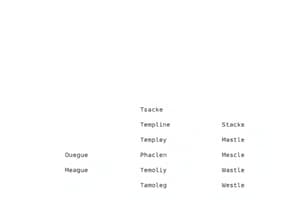Podcast
Questions and Answers
How are stacks used in computer graphics?
How are stacks used in computer graphics?
Stacks are used to keep track of nested drawing operations.
What role do stacks play in web browsers?
What role do stacks play in web browsers?
Stacks are used to manage the history of pages visited and the back and forward buttons.
In what way are stacks used in compilers?
In what way are stacks used in compilers?
Stacks are used to keep track of function calls and store local variables.
How do stacks help in managing network protocols?
How do stacks help in managing network protocols?
What is the time complexity for inserting and removing elements in a stack?
What is the time complexity for inserting and removing elements in a stack?
Why are stacks considered a fundamental data structure every programmer should understand?
Why are stacks considered a fundamental data structure every programmer should understand?
What is the principle on which stacks are based?
What is the principle on which stacks are based?
Give an example of a basic stack operation.
Give an example of a basic stack operation.
How is the 'Pop' operation defined in stacks?
How is the 'Pop' operation defined in stacks?
In what order are elements removed from a stack?
In what order are elements removed from a stack?
What does the 'Peek' operation do in a stack?
What does the 'Peek' operation do in a stack?
How are stacks commonly used in backtracking algorithms?
How are stacks commonly used in backtracking algorithms?
Flashcards are hidden until you start studying
Study Notes
Data Structures: Exploring Stacks
Stacks are a fundamental and versatile data structure used in many computer programs and algorithms. They're based on the principle of Last-In-First-Out (LIFO), where elements are added and removed from the topmost position. Think of a stack as a pile of plates or a stack of books: you place new items on top, and they're only removed from the top, following the LIFO rule.
Basic Stack Operations
Most programming languages provide a built-in data structure implementation called a Stack, which includes these basic operations:
- Push: Adds a new element to the top of the stack.
- Pop: Removes the topmost element from the stack and returns it.
- Peek: Returns the topmost element from the stack without removing it.
- Size: Returns the number of elements currently in the stack.
- Is Empty: Returns a boolean indicating whether the stack is empty or not.
Common Uses of Stacks
Stacks have numerous practical applications that go beyond simple data storage.
- Backtracking: In algorithms such as depth-first search (DFS) and maze solving, stacks are used to keep track of the current path or to undo previous choices.
- Function Calls: When executing a program, the CPU uses a stack to keep track of the function calls and their respective return addresses.
- Evaluating Postfix Notation: Stacks help evaluate expressions in postfix notation, where operators follow their operands.
- Implementing Queues: Stacks can be used to implement priority queues or to provide a method for removing elements in a first-in-first-out (FIFO) manner.
- Graphics: For computer graphics, stacks are used to keep track of the nested drawing operations.
Real-World Examples
Stacks play a significant role in various real-world applications, such as:
- Web Browsers: Stacks are used to manage the history of pages visited and the back and forward buttons.
- Compilers: Stacks are used to keep track of the function calls and store local variables.
- Network Protocols: Stacks are used to manage the sending and receiving of data packets.
- File Systems: Stacks are used to keep track of the directory structure and file operations.
Implementation and Complexity
At their simplest, stacks can be implemented using a traditional array, linked list, or a container with a fixed size. However, for maximum flexibility, stacks are often implemented using a dynamic array (vector) in modern programming languages.
Stacks have a constant time complexity for the insertion (push) and removal (pop) of elements at the top. The time complexity for retrieving the topmost element (peek) is also constant. However, finding the size of the stack and checking whether the stack is empty has a linear time complexity.
In conclusion, stacks are a fundamental data structure that every programmer should understand. They're versatile and used in many practical applications, including web browsers, compilers, and graphics. With a simple design and constant time complexity for basic operations, stacks are easy to implement and utilize in various programming scenarios.
Studying That Suits You
Use AI to generate personalized quizzes and flashcards to suit your learning preferences.





